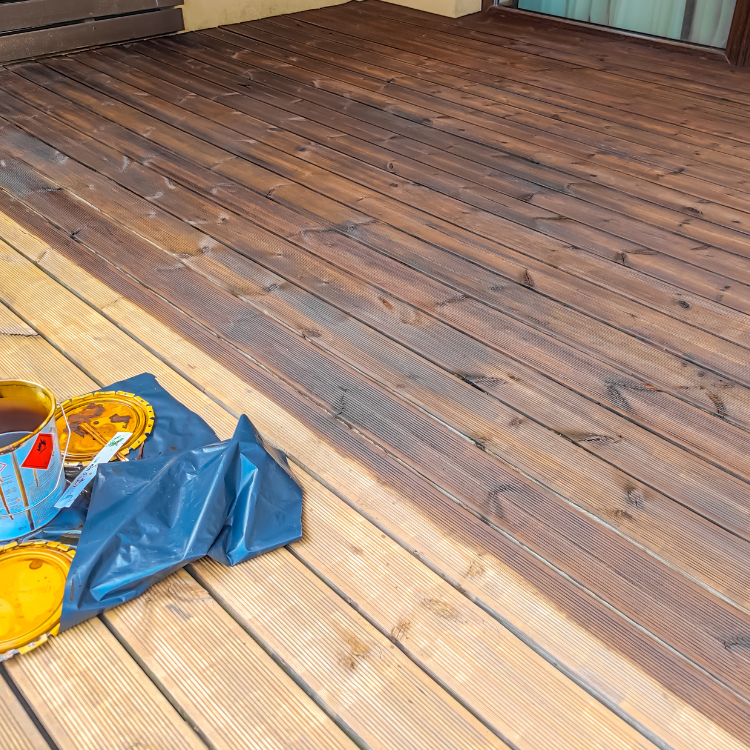Living in Evesham, NJ, you know how unpredictable the weather can be. Seasonal rain, humid summers, and snowy winters all contribute to one common issue—moisture damage. When it comes to preserving the beauty and durability of your deck, the way you paint and maintain it makes all the difference. Moisture can sneak into cracks and exposed wood, leading to rot, mold, and structural issues that compromise safety and appearance. Fortunately, the right deck painting methods can safeguard your outdoor space for years to come.
Key Takeaway: Moisture damage prevention starts with proper surface preparation, quality paint products, and ongoing maintenance. A well-painted deck is your first line of defense against water infiltration and structural deterioration.
Understanding Why Deck Painting Matters
The Role of Protective Coatings
Decks are constantly exposed to the elements, making protective coatings essential for long-term durability. Painting your deck doesn’t just enhance curb appeal—it seals the wood against moisture intrusion. High-quality coatings create a barrier that prevents water from soaking into the wood fibers, which helps reduce warping, splitting, and decay. For homes in Evesham, where humidity can fluctuate dramatically, this barrier is a necessity.
Moisture and Structural Integrity
When water penetrates untreated or poorly maintained wood, it weakens the internal fibers over time. This structural degradation often starts small but can escalate quickly, leading to costly repairs. If you want to avoid replacing entire sections of your deck, a strong deck repainting schedule is key. Applying fresh coats of paint or stain every few years ensures continued protection against these threats.
Preventing Mold and Mildew
Moisture trapped in the wood creates the perfect breeding ground for mold and mildew. Beyond being an eyesore, mold can cause slippery surfaces, making your deck unsafe. Choosing the right paint with mold-resistant properties helps maintain not only the deck’s aesthetic appeal but also the safety of your outdoor living area.
Preparing Your Deck for Painting
Thorough Cleaning for Better Adhesion
Preparation is everything when it comes to painting. Start by cleaning the surface thoroughly to remove dirt, debris, and any remnants of old finishes. Power washing is effective but must be done carefully to avoid damaging the wood fibers. For Evesham homeowners looking to refresh their outdoor space, this step lays the foundation for a smooth, long-lasting finish.
Repair Before You Paint
Any existing damage, such as cracks or loose boards, should be addressed before painting. Repairing these imperfections prevents water from seeping into vulnerable areas. If your deck has extensive wear, consider hiring a professional who can provide services like masonry, concrete, and stucco coatings for additional reinforcement around adjoining surfaces.
Sanding for a Smooth Finish
After cleaning and repairing, sanding is the next crucial step. It removes rough patches and old paint layers, ensuring that the new coat adheres properly. A smooth, even surface helps the paint form an impenetrable layer, maximizing moisture resistance.
Choosing the Right Paint for Moisture Protection
Acrylic vs. Oil-Based Paints
When it comes to outdoor decks, not all paints are created equal. Acrylic latex paints are popular for their flexibility and ability to resist cracking, which is essential in climates with varying temperatures like Evesham. Oil-based paints, on the other hand, penetrate deeper into the wood, offering superior moisture blocking but requiring more maintenance over time.
Water-Resistant Features Matter
Select a paint specifically designed for exterior use and enhanced with water-resistant properties. These products create a stronger seal that protects against rain, snow, and humidity. If you want added protection, consider pairing the paint with a water-repellent primer for a double barrier.
Color Considerations and Heat Reflection
The color you choose impacts more than aesthetics. Lighter shades reflect heat, reducing thermal expansion that can cause cracks, while darker colors absorb more heat, which might accelerate wear in direct sunlight. Striking the right balance keeps your deck visually appealing and structurally sound.
Application Techniques for Maximum Protection
Using the Right Tools
Brushes, rollers, and sprayers each have advantages, but combining them often delivers the best results. Brushes ensure paint gets into every groove and corner, while rollers and sprayers provide a smooth, even coat on larger areas. Taking the time to use the proper tools ensures comprehensive coverage.
Multiple Thin Coats Over One Thick Layer
Applying multiple thin coats creates a more durable finish than one heavy application. Thin coats dry more evenly, reducing the risk of peeling or bubbling later. Between coats, allow adequate drying time to ensure the paint forms a solid seal.
Don’t Forget the Underside
Many homeowners overlook the underside of the deck boards, but this area is equally vulnerable to moisture. Applying paint or sealant underneath prevents water from wicking up into the wood, offering complete protection from top to bottom.
Maintaining Your Painted Deck
Regular Inspections After Rainy Seasons
Inspect your deck regularly, especially after heavy rains or snow. Look for peeling paint, soft spots, or signs of mold. Addressing these issues promptly prevents minor problems from escalating into major repairs.
Quick Touch-Ups for Ongoing Protection
Small chips or scratches in the paint may seem harmless, but they expose the wood to moisture. Keep a small supply of matching paint on hand for touch-ups. This proactive approach extends the lifespan of your deck and saves you from costly repairs.
Professional Help for Major Repaints
While DIY projects can be rewarding, some situations call for expert assistance. If your deck is significantly weathered, professionals offering exterior painting services in Evesham can restore it to its former glory with precision and care.
Answering Common Questions
How often should I repaint my deck? On average, a well-painted deck needs a fresh coat every two to three years. However, factors like weather conditions and foot traffic may shorten this timeframe. Regular inspections will help you determine when it’s time for a new coat.
Can I paint over an old stain? Yes, but the surface must be thoroughly prepared. Cleaning, sanding, and applying a suitable primer are critical to ensure the new paint adheres properly and provides the desired protection.
Is staining better than painting for moisture protection? Both methods have their benefits. Staining penetrates the wood for deep protection, while painting creates a surface barrier. Combining the two or opting for a high-quality deck paint can deliver excellent results against moisture damage.
The Impact of Evesham’s Climate on Your Deck
Evesham’s seasonal shifts can be tough on wood decks. Heavy rains, high humidity, and winter snow create a perfect storm for moisture intrusion. Knowing how these elements interact with your deck’s material helps you choose the best protective methods.
How Deck Painting Enhances Longevity and Value
Painting your deck doesn’t just protect—it adds beauty and value to your home. A well-maintained deck enhances curb appeal, making your outdoor space inviting while boosting property value. Investing in professional services such as interior painting and deck care ensures your home remains beautiful inside and out.
Why Professional Services Make a Difference
While DIY efforts can help, professional painters bring expertise, tools, and premium products that ensure lasting results. If you’re ready to transform your outdoor space and protect it from the harsh elements, reach out to our team at Bucci Paint for quality care that goes beyond the surface. Explore our services, including general remodeling, to elevate every corner of your home.

